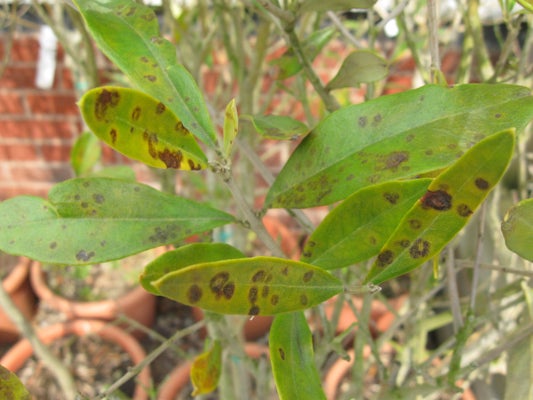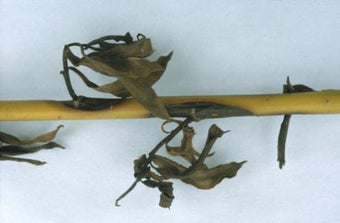
Quick facts
Common name - Olive scab, olive leaf spot, peacock spot, bird’s-eye spot
Scientific name - Venturia oleaginea
Plants affected - Olive
Main symptoms - Ring-like or solid circular leaf spots, leaf fall
Caused by - Fungus
Timing - Symptoms visible all year; spreads during spring and summer
What is olive scab
Olive scab is a fungal disease that attacks olive (Olea) species. It affects the leaves, and severe attacks are not only unsightly but can reduce the vigour of the tree by causing premature leaf fall. Wet weather is necessary for the spores of the fungus to infect the leaves.
Symptoms
You may see the following symptoms:
- Purple or brown, circular leaf spots
- Symptoms may take the form of purple or brown rings enclosing a green or yellow centre, or they may be solid purple or brown circles
- There may also be a yellow or purple halo surrounding the spot, and this ‘zoned’ effect gives the disease one of its alternative names of peacock spot; the appearance is not unlike that of the eyespot on a peacock feather
- Affected leaves turn yellow and fall prematurely
- Repeated severe attacks may reduce vigour and lead to twig dieback
Lesions developing on the fruit stalk can lead to fruit being shed, but spots are not usually produced on the fruit itself
Control
The RHS believes that avoiding pests, diseases and weeds by good practice in cultivation methods, selection, and encouraging or introducing natural enemies, should be the first line of control. If chemical controls are used, they should be used only in a minimal and highly targeted manner.
Non-chemical control
- Remove and dispose of fallen leaves, to reduce the risk of these acting as a source of spores
- Prune out twigs with dieback
- Avoid placing trees in areas where the air circulation is poor
- Pruning to give a more open canopy will also improve air circulation, lowering and ensuring that the leaves dry out more quickly after rainfall. Avoid pruning too hard, however, as this can result in the production of non-fruiting water shoots
Fungicides
The RHS recommends that you don't use fungicides. Fungicides (including organic types) may reduce , impact soil health and have wider adverse environmental effects. If you do intend to use a fungicide, please read the information given in the link and download below to ensure that use, storage and disposal of the product is done in a responsible and legally compliant manner.
The products listed in the ‘Fungicides for gardeners’ document below are legally available for use by home gardeners in the UK. This information is provided to avoid misuse of legal products and the use of unauthorised and untested products, which potentially has more serious consequences for the environment and wildlife than when products are used legally. Homemade products are not recommended as they are unregulated and usually untested.
There is no specific information available on the efficacy of any home garden fungicide against olive scab.
No fungicides are available to gardeners for use on olive trees from which the fruit will be harvested and consumed.
Download
Fungicides for gardeners (Adobe Acrobat pdf document outlining fungicides available to gardeners)
Link
Biology
The olive scab fungus Venturia oleaginea is closely related to the fungi that cause scab diseases on other plants such as apples, pears, pyracantha and Sorbus. The disease is widespread in the Mediterranean and is found in most countries where olives are grown.
The spores of the fungus are spread by rain-splash, and warm, wet conditions are ideal for infection. In the Mediterranean such conditions occur in autumn and winter, but in the UK temperatures during spring and summer are more suitable.
A healthy olive leaf normally lasts for about 18 months, and old leaves are shed intermittently by the tree so that it maintains a good canopy. Unfortunately, severe olive scab infection can lead to large numbers of leaves falling well before they reach this age.



